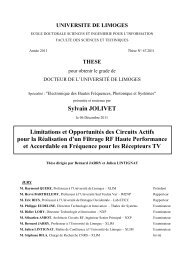Extraction, caractérisation chimique et valorisation biologique de ...
Extraction, caractérisation chimique et valorisation biologique de ...
Extraction, caractérisation chimique et valorisation biologique de ...
Create successful ePaper yourself
Turn your PDF publications into a flip-book with our unique Google optimized e-Paper software.
Figure 30 : Dérivés furfuriques obtenus par déshydratation <strong>de</strong>s pentoses, <strong>de</strong>s hexoses <strong>et</strong> <strong>de</strong>s<br />
aci<strong>de</strong>s uroniques ....................................................................................................................... 43<br />
Figure 31 : Stabilité <strong>de</strong> la liaison uronosidyle à l’hydrolyse aci<strong>de</strong> .......................................... 45<br />
Figure 32 : Préparation <strong>de</strong>s O-méthylglycosi<strong>de</strong>s ..................................................................... 46<br />
Figure 33 : Equilibre mutarotationnel du xylose ...................................................................... 48<br />
Figure 34 : Métho<strong>de</strong> <strong>de</strong> triméthylsilylation <strong>de</strong>s O-méthylglycosi<strong>de</strong>s ...................................... 49<br />
Figure 35 : Principe du dosage enzymatique <strong>de</strong>s acétyles ....................................................... 50<br />
Figure 36 : Hydrolyse enzymatique <strong>de</strong> GX. ............................................................................. 52<br />
Figure 37 : Mécanisme général <strong>de</strong> l’hydrolyse aci<strong>de</strong> <strong>de</strong>s glycosi<strong>de</strong>s ...................................... 53<br />
Figure 38 : Catalyse intramoléculaire par un groupement carboxyle d’une liaison 1→4<br />
précédant un aci<strong>de</strong> uronique ..................................................................................................... 54<br />
Figure 39 : Dépolymérisation en milieu basique ou peeling d'un glycane lié en 1→4 ............ 55<br />
Figure 40 : Dégradation alcaline en milieu réducteur d’un polysacchari<strong>de</strong> aci<strong>de</strong> ................... 56<br />
Figure 41 : Libération <strong>de</strong>s substituants R1, R2, R3 en milieu aci<strong>de</strong> après la β-élimination ...... 56<br />
Figure 42 : Schéma représentant les corrélations 3 JH,C carbone/proton observées à partir du<br />
proton H-1 dans une expérience HMBC. La corrélation la plus intéressante est celle qui<br />
indique la liaison glycosidique. ................................................................................................ 59<br />
Figure 43 : Principe du MALDI ............................................................................................... 61<br />
Figure 44 : Exemples d’application <strong>de</strong>s xylo-oligosacchari<strong>de</strong>s ............................................... 68<br />
Figure 45 : Xylanes fonctionnalisés ......................................................................................... 69<br />
Figure 46: Hydrolyse <strong>de</strong>s xylanes <strong>et</strong> exemples d’applications industrielles ........................... 71<br />
Figure 47 : Formation d’une cétone C-xylosidée. .................................................................... 72<br />
Figure 48 : Réduction <strong>de</strong> la cétone C-xylosidée....................................................................... 72<br />
Figure 49: Protocole d’extraction <strong>de</strong> polysacchari<strong>de</strong>s pariétaux ............................................. 79<br />
Figure 50 : <strong>Extraction</strong> alcaline <strong>de</strong> xylanes ............................................................................... 80<br />
Figure 51 : Spectre RMN 1 H (D2O) du xylane extrait dans le DMSO aux micro-on<strong>de</strong>s après<br />
prétraitement aux ultrasons. ..................................................................................................... 87<br />
Figure 52 : Principe <strong>de</strong> la délignification enzymatique ............................................................ 89<br />
Figure 53 : Protocole d’obtention <strong>de</strong> xylanes après délignification enzymatique ................... 90<br />
Figure 54 : Disposition <strong>de</strong>s essais. ........................................................................................... 92<br />
Figure 55 : Disposition <strong>de</strong>s essais lorsque l’on ne fait varier qu’un seul facteur à la fois.. .... 93<br />
Figure 56 : Tracé <strong>de</strong>s eff<strong>et</strong>s moyens sur la quantité en phénols ............................................... 95<br />
Figure 57 : Tracé <strong>de</strong>s eff<strong>et</strong>s moyens <strong>de</strong>s facteurs pour le ren<strong>de</strong>ment massique en xylanes ..... 96<br />
Figure 58 : Spectre IR <strong>de</strong>s résidus après délignification par le système laccase/oxygène/HOBt<br />
<strong>et</strong> par le chlorite <strong>de</strong> sodium ...................................................................................................... 98
















